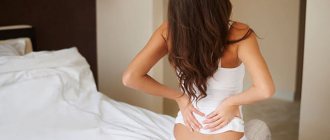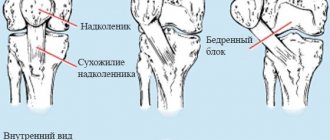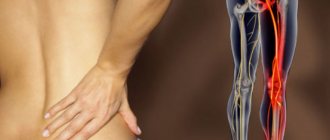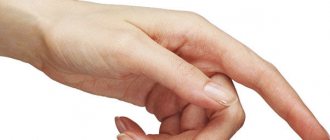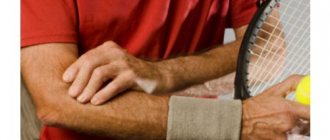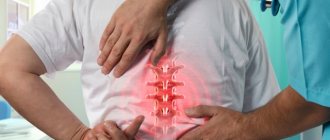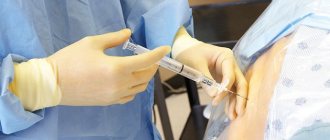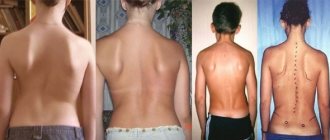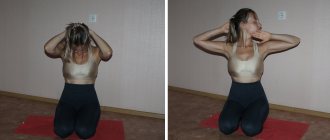Lower back pain is often referred to by terms such as lumbago or lumbodynia. Lumbago or “lumbago” is an attack of acute pain in the lower back, which is usually associated with hypothermia and stress. Lumbago occurs in many people and is often the cause of temporary disability. Often the cause of lumbago can be sports injuries or sprains, but sometimes the factor that triggers the pain remains unknown. Lumbago is characterized by pain without radiating to the legs. Low back pain (lumbago) may appear acutely and gradually progress throughout the day. Stiffness often occurs in the morning and gradually the stiffness turns into pain. Curvature of the spine (antalgic scoliosis) as a result of muscle spasm is also possible. The pain itself can be caused by muscle spasm, which in turn is associated with other causes. This could be overuse or sprained ligaments, sports injuries, herniated discs, spondyloarthrosis (spondylosis), kidney disease (infections or kidney stones). Sometimes the patient accurately determines the cause-and-effect relationship between the onset of malaise and stress, hypothermia, but often the pain appears without obvious reasons. Sometimes lower back pain can appear even after sneezing, bending over, or when putting on shoes. This can be caused by deforming diseases of the spine, such as scoliosis.
Unlike lumbago, the term lumbodynia refers to pain that is not acute, but subacute or chronic. As a rule, pain with lumbodynia appears gradually over several days. Pain may also occur in the morning and may decrease with physical activity. Lumbodynia is characterized by increased pain during prolonged static loads (sitting, awkward body position). It is also characteristic of lumbodynia that the pain decreases when lying down in a certain position. Patients with lumbodynia have difficulty performing normal activities such as washing or putting on shoes due to muscle spasms. Due to the disease, there is a decrease in the range of movements of the body (bending forward or, to a lesser extent, bending to the side or extension). Due to pain, the patient often has to change position when it is necessary to sit or stand. Unlike lumbago, muscle spasm is less pronounced and, as a rule, does not cover the entire lower back, and there are often signs of spasm predominance on one side.
Night back pain and its causes
The main signs of “safe” back pain include: association with physical activity or posture, absence of severe chronic illnesses, injuries, fever or numbness of the skin. If your back hurts mainly at night, it is advisable to understand the sources of discomfort. Here are a number of diseases that can cause night pain:
- Diseases of the gastrointestinal tract. Night pain radiating to the back is characteristic of an ulcer, sometimes pancreatitis or cholecystitis. Such pain is not relieved by massaging the painful area or changing body position.
- Kidney diseases. The lower back may ache with pyelo- and glomerulonephritis. Such pain is usually accompanied by an increase in body temperature and a change in the color of urine.
- Inflammatory diseases of the vertebrae and intervertebral discs. If the pain at night is intense and prolonged, a doctor’s examination is definitely necessary. Sometimes it is better to be safe than to miss a dangerous condition.
- Most often, night back pain is associated with muscle overload during the day or an uncomfortable bed.
Diseases of internal organs
If your back hurts in the lumbar region for no particular reason, this indicates internal pathologies. Let's take a closer look at these diseases.
Pyelonephritis
Inflammatory kidney disease. They are detected by blood and urine tests, as well as by ultrasound of the kidneys. The patient is referred to a nephrologist who prescribes treatment:
- Antibiotics – Ceftriaxone, Norfloxacin.
- Sulfonamides – Metrogyl.
- Antispasmodics – No-Shpa, Papaverine.
- Antipyretics – Paracetamol.
- Analgesics – Analgin.
- Diuretics – Canephron, Urolesan, decoctions of birch buds, knotweed, lingonberry leaves.
What is pyelonephritis
Advanced pyelonephritis leads to arterial hypertension, renal failure and necrosis of organ tissue.
Women's diseases
A gynecologist makes a diagnosis using blood, urine and vaginal smear tests. A gynecological ultrasound is performed.
The following drugs are used in treatment:
- Antibiotics – Oxacillin, Rifampicin.
- Sulfonamides – Sulfadimethoxine.
- Anti-inflammatory – Nurofen, Paracetamol.
- Antifungals – Fluconazole, Nystatin.
- Antiviral - Groprinosin, Acyclovir.
- Antispasmodics – No-Shpa, Drotaverine.
- Vaginal suppositories – Polygynax, Hexicon.
Physiotherapy is used. Sometimes, surgery is necessary. Advanced diseases lead to infertility, cancer and the spread of infection to other organs and the peritoneum.
Inflammation of the prostate gland in men
Detected using tank. culture of urine and prostate discharge. The diagnosis is confirmed based on rectal examination and ultrasound. The urologist selects treatment therapy, which usually includes:
- Broad spectrum antibiotics – Amoxicillin, Cefixime.
- Anti-inflammatory NSAIDs - Ketoprofen, Piroxicam, Nimesil.
- Drugs that normalize peripheral blood circulation - Pentoxifylline, Trental.
- Analgesics – Ketanov, Tempalgin.
What is prostate inflammation?
Bed rest and prostate massage are prescribed during the period when acute symptoms subside. The consequences of prostatitis are the spread of the inflammatory process, abscess and prostate adenoma.
Inflammatory processes in the gastrointestinal tract
Diseases are treated by a gastroenterologist, sometimes a proctologist. It is detected using blood, urine and stool tests, ultrasound or CT scan of the abdominal organs, intestinal colonoscopy and FGS.
Treatment consists of the following medications:
- Antispasmodics – Duspatalin, Buscopan.
- Enzymes – Pancreatin, Festal.
- Sorbents – Polysorb, activated carbon.
- Probiotics – Acipol, Hilak Forte.
- Antacids - Phosphalugel, Gastal.
- Choleretic - Hofitol, Karsil.
Advanced pathologies lead to impaired digestion of food, erosions and tumors of the gastrointestinal tract, and internal bleeding.
Why does my lower back hurt during sleep?
A typical situation for nighttime lower back pain: only one side of the back hurts, or the pain is felt in the middle at the very depths. In this case, turning on the other side or on the stomach, if not completely relieves pain, then significantly alleviates it. All the signs described indicate that it is time to pay attention to the shape of the lumbar spine.
Lumbar lordosis is the most important curve of the spine; it plays the role of a natural shock absorber for the back. Both an overly flat and an overarched lumbar spine reduce stability and increase the risk of injury. The absence of scoliosis is also of great importance. Lateral bending disrupts core muscle function and is also associated with a higher incidence of pain.
The main cause of nighttime muscle pain in the lower back is the lack of support for the highest points of the spine by the surface of the mattress. Such pain is characteristic of both excessive lordosis and scoliosis of the lumbar region. Sometimes a flat back or an anatomically correct spine with spondyloarthrosis – “worn out” intervertebral joints – can hurt.
Methods of treatment and prevention
A competent doctor always takes into account the circumstances surrounding the occurrence of pain. In this case, discomfort appears at night, and one of its causes may be an incorrect position during sleep. We’ll talk about the features of orthopedic neck pillows in another article, and in this one we’ll focus on solutions for the lower back.
Somnologists (scientists who study sleep) recommend at least two pillows for comfortable sleep. If you sleep on your side, one, of course, is located under your head, and the second should be placed between your knee joints. This maintains the neutral position of the pelvis, to which the back muscles are attached.
In the supine position, the second pillow is placed either under the lower back or under the knee joints. If the lumbar curve is pronounced, it is the lumbar pillow that works well, if the back is flat, leg support. Thanks to the second pillow, the muscles of the legs and back are maximally relaxed, their tension and pain are eliminated.
Overloading the lower back during the day is also important. To prevent your back from hurting at night, take care of it during the day. Sit less and do gymnastics more often. If you still have to sit, use pillows or bolsters for your back: they bring the lower back into the correct position and tone.
Diagnosis of spinal diseases, which doctor treats
If the spine hurts in the lumbar region, the patient is referred to an orthopedist or vertebrologist. The specialist examines the spinal column and back muscles. Additionally, an X-ray, computed tomography of the diseased area or MRI is performed.
Computed tomography is a popular method for identifying spinal diseases
Spinal pathologies are closely related to neurological manifestations. Therefore, you will need to consult a neurologist, vertebrologist, orthopedic surgeon, or neurosurgeon. In some cases, Doppler ultrasound (USDG) and EMG are prescribed.
Physiotherapeutic treatment
The treatment complex includes the following procedures:
- Magnetotherapy.
- Electrophoresis.
- Ultrasonic action.
- Darsonvalization.
- Vibration therapy.
Be sure to read: TOP 10 reasons why the spine in the middle of the back hurts, treatment methods
This reduces inflammation and pain in soft tissues, stimulates local immunity, and improves mobility.
The following inexpensive devices will help you at home.
Almag
The device acts on the cause of pain using a magnetic pulse field. It is intended to treat the following diseases:
- arthrosis and arthritis;
- osteochondrosis of any localization;
- injuries (fractures);
- intervertebral hernia;
- muscle pain.
After the procedures, inflammation and swelling are eliminated, muscle spasms are relieved and pain is reduced. The method has contraindications.
DENAS
A device that acts on the body through electrical neurostimulation. The therapeutic effect is achieved by influencing reflexogenic points of the body.
An effective and safe method of treating various pathologies. At the same time, the condition of the spine and the whole body is normalized. Approved for use in cancer patients.
Back Rescue Plan
If the pain is severe, then at the first appointment the doctor prescribes medications that will alleviate the patient’s condition. To treat the spine and joints, non-steroidal anti-inflammatory drugs are usually used, the purpose of which is to block the body's release of substances that cause pain. The second purpose is drugs that relax the muscles. Doctors often forget to warn that their use is incompatible with alcohol: these drugs also relax the muscles responsible for breathing, and ethanol enhances their effect. The third prescription will be for B vitamins.
In Russia, it is customary to prescribe all these medications first by injection, and then transfer the patient to tablets. We still believe that the effect of a drug depends on the route of administration, but for modern drugs such a difference has not been proven; tablets are just as effective as injections. At the same time, the patient can take the pills at home, but with a sore back it is difficult to go to the treatment room. In addition, all drugs for back treatment are painful when administered.
When the first stage of treatment ends, tests come. After making sure that everything else is in order, the therapist refers the patient to a neurologist or vertebrologist. They include methods of influencing muscles - manual therapy, massage, physiotherapeutic procedures (usually electrophoresis or magnetic therapy), physical therapy.
Complete treatment of the back and spine is impossible without strengthening the muscle frame. Medicines and even physical therapy are only temporary measures that relieve spasms, relax the muscles, and the disease goes away until the next awkward movement or poor sleeping position. Therefore, physical education - first therapeutic, and then, at the patient’s choice, fitness, yoga, swimming, or all in combination - is a necessary part of therapy, as important as painkillers and relaxation pills at the first stage.
Complex drugs
Such products contain more than 1 active ingredient.
- Neurodiclovit. An effective drug with diclofenac and B vitamins. Price from 310 rubles;
- Dolaren. This is paracetamol + diclofenac;
- Next This is paracetamol + ibuprofen. Price from 160 rubles;
- Katadolon Forte. Has the effect of a muscle relaxant and NSAID. Price from 900 rub.
Katadolon Forte is an effective pain reliever
Contains B vitamins and diclofenac sodium. Costs from 300 rub.
Homeopathy
Drugs that reduce pain due to antispasmodic action. Reduce inflammation and pain using the internal resources of the human body.
- Discus compositum - from 1309.7 rubles;
- Traumeel S – from 130 rubles;
- Rus-Plus - from 310 rubles;
- Goal T - from 451 rub.
Homeopathic remedies are not considered medicines and should be prescribed by an experienced homeopath.
Candles
Suppositories with an anti-inflammatory and analgesic effect at an early stage of the disease are good at stopping a pain attack.
The most effective of them:
- Amelotex - from 144 rubles;
- Diclovit - from 170 rubles;
- Indomethacin – from 410 rubles;
- Ketoprofen – from 160 rubles;
- Diclofenac (analogue - Naklofen) - from 50 rubles;
- Ketonal - from 270 rubles;
- OKI (analogues – Artrosilene and Ketonal) – from 300 rubles;
OKI - relatively safe pain-relieving suppositories - Voltaren - from 305 rub.
They dissolve in the rectum and the active substances are absorbed into the blood. The effect occurs faster than that of tablets and capsules.
Ointments
External agents are applied to the affected area 3-4 times a day. With their help, it is possible to achieve pain relief and improvement in condition.
Effective warming ointments that are applied only with an applicator:
- Capsicam - from 115 rubles;
- Finalgon - from 316 rubles;
- Nicoflex – from 360 rub.
Ointments with an anti-inflammatory or irritating effect are used throughout the treatment period.
Pain relieving ointments:
- Orthoflex - from 80 rubles;
- Ortofen - from 150 rubles;
- Amelotex – 190 RUR;
- Ketonal - from 430 rubles;
- Nise gel – from 275 RUR;
Nise gel is an inexpensive and effective local remedy - Ketoprofen - from 90 rubles;
- Fastum gel - from 280 rubles;
- Diclovit - from 170 rubles;
- Diclofenac. Inexpensive and effective ointment (gel) - from 50 rubles;
- Bystrumgel - from 250 rubles;
- Dolgit (Ibuprofen) – 98 rubles;
- Voltaren emulgel – from 235 rubles;
- Indomethacin ointment – from 60 rub.
- Dolobene. A good ointment with complex action – from 480 rubles;
- Bishofite – from 80 rub.
The use of ointments with venom from snakes and bees gives a good effect:
- Viprosal B - from 380 rubles;
- Apizartron – from 330 rub.
Plasters
Effective agents with anti-inflammatory, analgesic, and warming effects.
- Pepper patch – from 9 rubles;
- Voltaren - from 143 rubles;
- Versatis with lidocaine – from 850 rubles;
- Ketonal Thermo - from 690 rub.;
The patch is glued to the lower back and left for the time specified in the instructions.
Traditional treatment for severe pain
Traditional medicine methods are effective and harmless. Here are some recipes:
- Take a piece of sheepskin cloth that matches the size of the affected area. Sew elastic bands to it so that it can be worn as a belt. Dissolve a large handful of table salt in a bowl of hot water and dip the belt in it for 1.5 hours. Remove, squeeze and dry. Can be worn continuously until symptoms disappear.
- Lightly massage the sore spot with “Star” balm. Bandage a sheet of foil on top and insulate it. Leave the compress overnight.
- Lubricate the lower back with honey and cover with a cloth. Moisten mustard plasters with warm water and place on a cloth. Cover your back for 1 hour. Then remove the compress and clean the skin with a damp cloth. Wrap up and go to bed.
Interesting article in continuation:
TOP 15 folk remedies for back and lower back pain
Consequences
Most spinal diseases cause disability and paralysis of the limbs if timely treatment and diagnosis are not carried out.
- Osteochondrosis in its advanced form will develop into protrusion and intervertebral hernia.
- Lumbar hernia often causes surgery. Otherwise, the patient faces paralysis of the legs. A good article in continuation: Hernia of the lumbar spine: what is it, causes, symptoms, stages, diagnosis
Lumbar hernia is a serious complication - Radiculitis is complicated by poor circulation in the affected area and spinal cord infarction.
- Sciatica leads to limited mobility of the legs and dysfunction of the knee and ankle joints.
- Spondyl e s passes into a deforming stage, during which the spinal canal narrows. This will lead to disturbances in the functioning of the limbs and internal organs.
- Ankylosing spondylitis without proper treatment will lead to kidney damage. Pathology of the thoracic region leads to heart disease, which poses a real threat to life and health.
